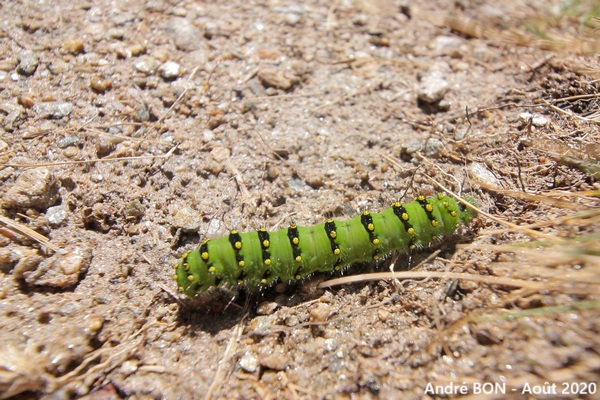


| Emperor Moth (Saturnia pavonia (Linnaeus, 1758)) |



|
|
Scientific name: Saturnia pavonia (Linnaeus, 1758) Common name: Emperor Moth French name: Petit Paon de Nuit Order: Lepidoptera Suborder: Heterocera Family: Saturniidae Subfamily: Saturniinae Wingspan: 50-64 mm. Biotope: Fallow lands, heathlands, meadows, clearings, up to an altitude of 2000 m. Geographic area: From western Europe, east to the Amur river. Flight time: April-May. Number of generations : 1 Caterpillar: The caterpillar is first black with orange marks. Then it becomes green, circled with black, with yellow spots on the black rings. Some are missing the black marks. Host plant: Many species like Blackthorn (Prunus spinosa), Heath (Erica), Hornbeam (Carpinus), Sea Buckthorn (Hippophae), Bramble (Rubus), Hawthorn (Crataegus), etc. |
The female is a grey colour. The tip of the forewings are reddish-brown. The male is brown with yellowish hindwings. The hindwings show, on both sexes, a large eyespot on a white mark, between two wavy lines. Males bear feathery antennae. They fly during the day and can detect females at a distance of more than 2 kilometres. Females are slightly larger than males. They have notched antennae. They stay still inside the vegetation before mating. Emperor Moths do not feed in the imago stage so they only live about ten days in this stage. |
| [To know more about the Emperor Moth] [Next picture] [Top] |

|
Quite impossible not to see this big fat bright green caterpillar crossing the footpath in front of the crowd of hikers walking down the col de la Vanoise. |
| [To know more about the Emperor Moth] [Next picture] [Previous picture] [Top] |

|
Here is another caterpillar of Emperor Moth, crossing the hiking track. When will I take a picture of the imago? (I need to come here at spring …) |
| [To know more about the Emperor Moth] [Previous picture] [Top] |

|
Here is a caterpillar that still has its black rings. |